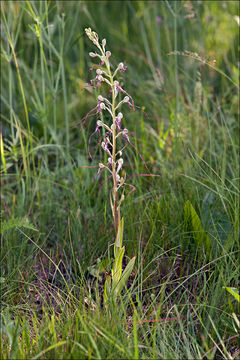Image of Adriatic lizard orchid

Description:
Slo.: jadranska smrdljiva kukavica - syn.: Himantoglossum hircinum ssp. adriaticum (Baum.) Sund., Loroglossum hircinum (L.) Rich. - Habitat: edge of a dry grassland, flat terrain, calcareous ground; open, sunny place; exposed to direct rain, average precipitations ~ 1.100 mm/year, average temperature 10 - 12 deg C, elevation 75 m (250 feet), submediterranean phytogeographical region. - Substratum: soil. - Comment: Himantoglossum adriaticum is an amazing endemic European orchid, which was long time considered a subspecies of much more common Himantoglossum hircinum. The distribution area of the former is much smaller, than that of the latter, but it is not sharply restricted to the region around the Adriatic Sea as the name would suggest. Plants can be found in a few southeast European countries. It is rare almost everywhere. Some countries have only a few tens of plants left. Situation is better in Croatia, Slovenia and Italy where populations, albeit usually small, seem to be stable. - Himantoglossum adriaticum is a highly endangered and strictly protected species. It is critically endangered in Czech Republic and Slovakia, highly endangered in Austria and Hungary and near threatened in Croatia. In Slovenia it is enlisted on theRed List of rare and endangered species, marked by 'V' representing a vulnerable species. - The plant is listed on Annex II of the European Habitats Directive, included under Annex B of the Convention on International Trade in Endangered Species of Wild Fauna and Flora (CITES) and listed on the IUCN Red List of Threatened Species. In Slovenia it is protected according to 'Uredba o zavarovanih prostoiveih rastlinskih vrstah' Url. RS, t. 46/2004 (Regulation of protection of wild growing plants, Official Gazette of Republic Slovenia, No.:46/2004). Let us hope all this will help in real life too! - Flowers are very beautiful and of bizarre shape, where especially the lip impresses with its very long, filiform, curly and delicately colored main lobe. This species starts to grow already in October or November and overwinters with a few leaves already developed. So it can flower very early and in this way escape frequent summer droughts in the Sub- and Mediterranean climate. As so many other orchids it also needs to live in community with fungi (Ref.3). Unfortunately, for a photographer, its ground leaves regularly wane before it is in its peak bloom. It is almost impossible to find a richly flowering plant, which would in the whole be still in good shape. Nothing similar exists in my country, so identification of this species is easy. - Ref.: (1) Personal communication with Mr. BrankoDolinar, http://www.orhideje.si/ (2) http://www.iucnredlist.org/details/162219/0 (3) http://www.researchgate.net/publication/265686837_Fungi_from_the_roots_of_the_terrestrial_photosynthetic_orchid_Himantoglossum_adriaticum (4) M.A. Fischer, W. Adler, K. Oswald, Exkursionsflora sterreich Liechtenstein, Sdtirol, LO Landesmuseen, Linz, Austria (2005), p 1046. (5) D. Aeschimann, K. Lauber, D.M. Moser, J.P. Theurillat, Flora Alpina, Vol. 2., Haupt (2004), p 1134. (6) H. Baumann, S. Kuenkele, R. Lorenz, Orchideen Europas, Ulmer (2006), p 112.
Included On The Following Pages:
- Life (creatures)
- Cellular (cellular organisms)
- Eukaryota (eukaryotes)
- Archaeplastida (plants)
- Chloroplastida (green plants)
- Spermatophytes (seed plants)
- Angiosperms (Dicotyledons)
- Monocots (Monocotyledons)
- Asparagales
- Orchidaceae (orchids)
- Himantoglossum
- Himantoglossum adriaticum (Adriatic lizard orchid)
This image is not featured in any collections.
Source Information
- license
- cc-by-nc-sa-3.0
- copyright
- 2015 Dr. Amadej Trnkoczy
- photographer
- Dr. Amadej Trnkoczy
- original
- original media file
- visit source
- partner site
- CalPhotos
- ID


